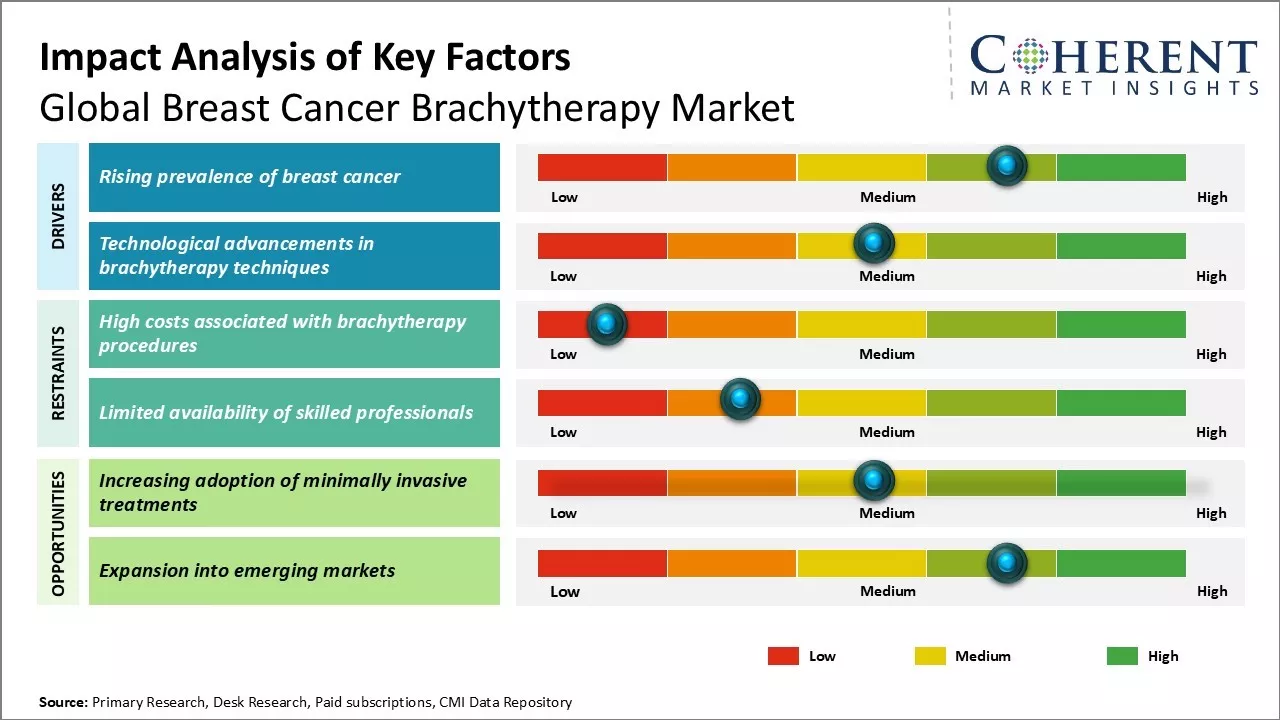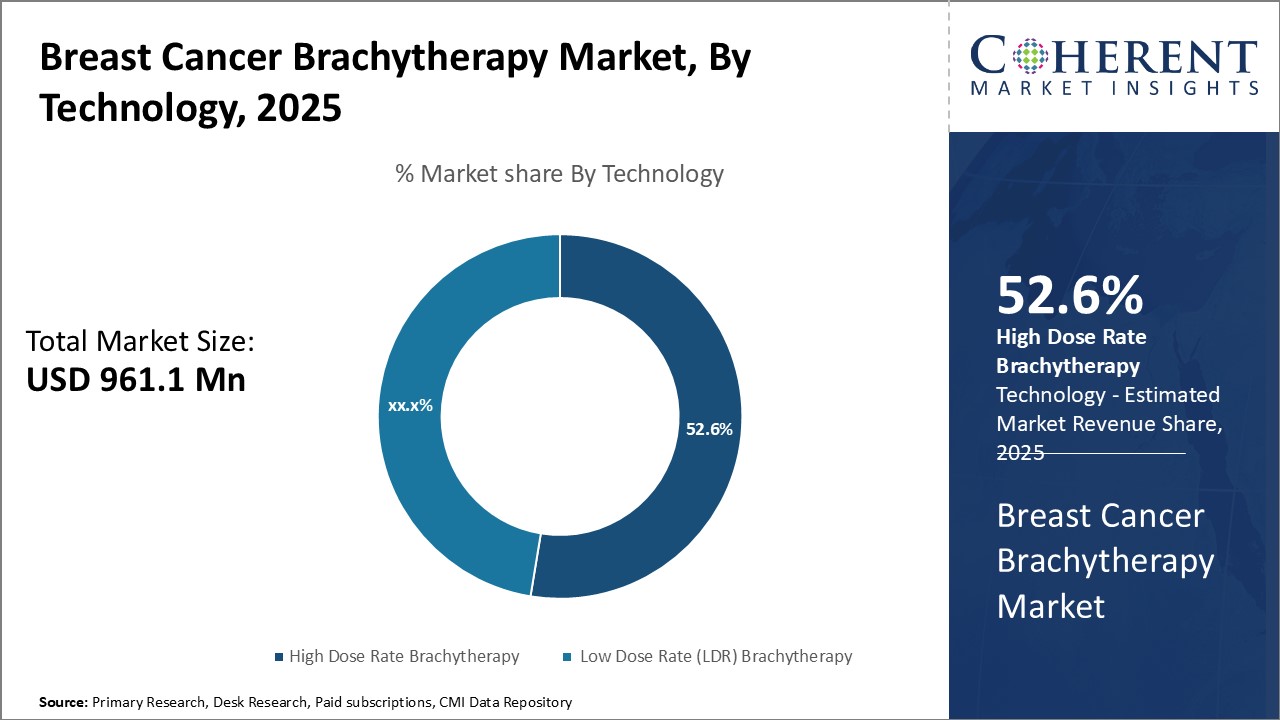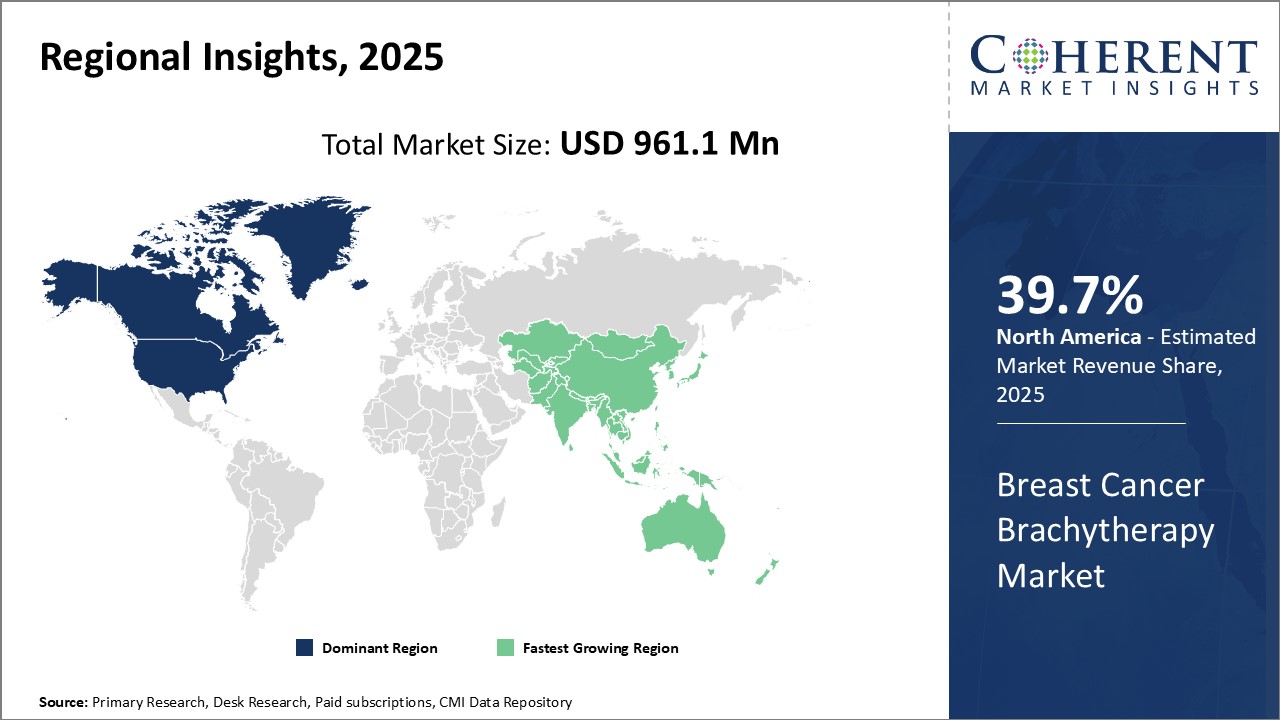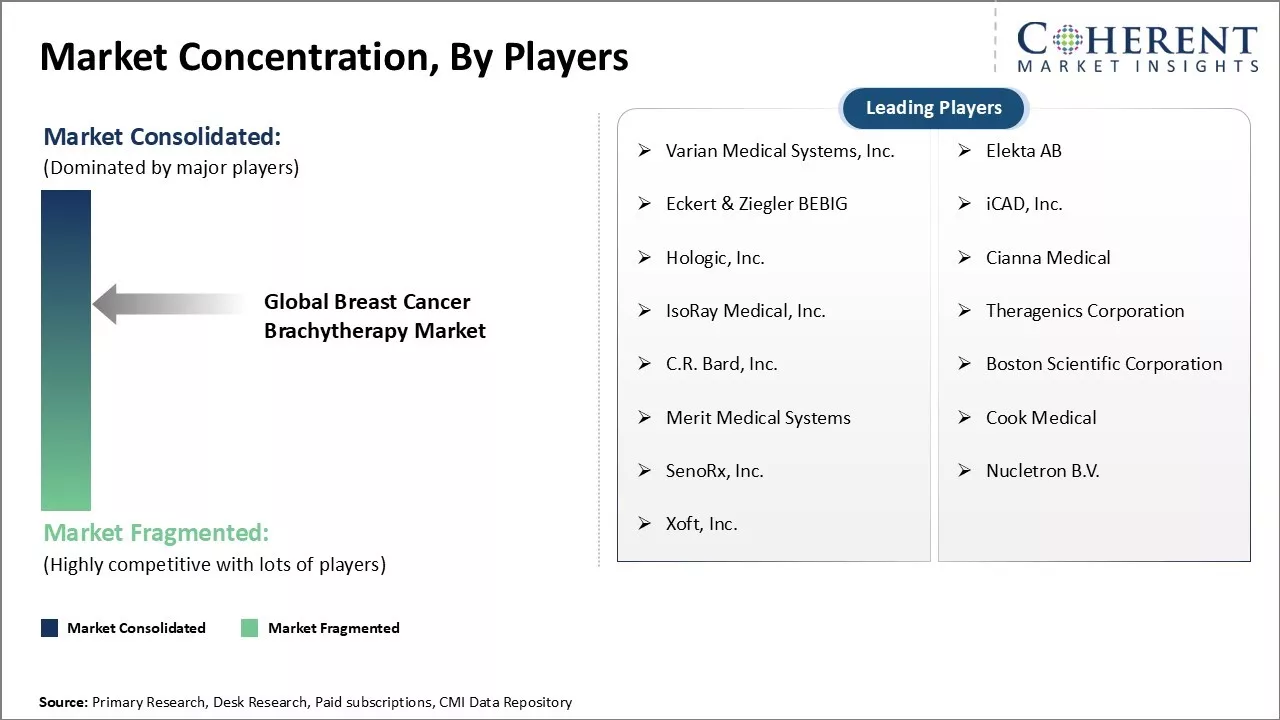Breast Cancer Brachytherapy Market Size and Trends
The global breast cancer brachytherapy market is estimated to be valued at USD 961.1 Mn in 2025 and is expected to reach USD 1,544.3 Mn by 2032, exhibiting a compound annual growth rate (CAGR) of 7.0% from 2025 to 2032.

Discover market dynamics shaping the industry: Download Free Sample
The non-invasive nature and localized radiation dose delivered make brachytherapy an attractive treatment option for breast cancer. Technological advancements in brachytherapy such as high dose rate and intensity modulated brachytherapy are improving the efficacy and outcome of the treatment.

Discover high revenue pocket segments and roadmap to it: Download Free Sample
Insights, By Technology - Technological Superiority Drives High Dose Rate Brachytherapy’s Dominance
High Dose Rate (HDR) brachytherapy segment is expected to dominate the market with 52.6% share in 2025 due to its ability to deliver concentrated radiation doses swiftly, enhancing tumor cell eradication while sparing healthy tissues. Its shorter treatment sessions reduce the risk of tumor cell repopulation, improving patient outcomes. Advanced 3D imaging facilitates real-time treatment planning and precise targeting of irregular tumors, offering superior dose conformity and distribution compared to Low Dose Rate (LDR) brachytherapy.
Insights, By Application - Early Diagnosis Drives Early-Stage Breast Cancer Segment’s Dominance
Early-stage breast cancer segment is estimated to hold the largest share of 34.62% in 2025. Advancements in screening have increased early diagnoses, and brachytherapy offers targeted radiation post-lumpectomy, sparing healthy tissues. This approach provides tumor control comparable to mastectomy while preserving breast integrity. Additionally, brachytherapy is cost-effective and requires fewer hospital visits than whole-breast radiotherapy, enhancing patient convenience.
Insights, By End User - Preference for Hospital-based Care Drives Its Dominance
Hospitals segment is estimated to dominate with share of 40.62% in 2025 due to their advanced equipment, specialized staff, and comprehensive inpatient facilities essential for complex radiation treatments. They ensure safe handling of radioactive materials and facilitate multidisciplinary collaboration among surgeons, radiation oncologists, and medical physicists, enhancing treatment efficacy and patient safety.
Regional Insights

Need a Different Region or Segment? Download Free Sample
Dominating Region: North America
North America dominates the breast cancer brachytherapy market with an estimated share of 39.7% in 2025. This can be attributed to factors such as the region's robust healthcare infrastructure and widespread medical insurance coverage. Major players like Cook Medical in the region also engage in new product innovations and strategic collaborations to cater to the growing demand.
Fastest-Growing Region: Asia Pacific
The Asia Pacific region exhibits the fastest growth and is expected to rise at a noteworthy pace during the forecast period. This can be credited to rising healthcare spending, increasing cancer incidence, and growing medical tourism in the region.
Breast Cancer Brachytherapy Market Outlook for Key Countries
U.S. Leads the Market with Advanced Technology
The U.S. dominates the breast cancer brachytherapy market due to the high incidence rates of breast cancer. For instance, in May 2020, according to data published in American Cancer Society, approximately 279,100 new cases of cancer are expected in 2020 in the U.S. The presence of advanced healthcare facilities and significant investments in oncology treatments contribute to robust market growth, and is projected to reach USD 897 million by 2025.
Growing Adoption of Innovative Treatments in Canada
Canada’s breast cancer brachytherapy market growth is driven by increasing awareness and adoption of brachytherapy for breast cancer treatment, supported by a strong healthcare system and rising healthcare expenditures. In May 2024, the Canadian Cancer Society reported that about 26.5% of women will develop breast cancer during their lifetime, emphasizing the need for effective treatment options.
Expanding Healthcare Infrastructure in China
China breast cancer brachytherapy market is expanding rapidly due to increasing breast cancer prevalence. For instance, according to China National Cancer Centre, in February 2024, with over 300,000 new cases reported annually, substantial government investments in healthcare infrastructure and initiatives aimed at improving treatment accessibility are key factors driving the market growth.
Strong Focus on Patient Care and Innovation in the U.K.
In February 2023, the World Health Organization reported that Europe experiences approximately 500,000 new breast cancer cases annually, underscoring the urgent need for effective treatments like brachytherapy. The region's advanced healthcare infrastructure, increased investments in oncology research, supportive government initiatives, and collaborations among key industry players to develop innovative brachytherapy devices are significantly enhancing the adoption of this targeted therapy across Europe.
Market Concentration and Competitive Landscape

Get actionable strategies to beat competition: Download Free Sample
Top Strategies Followed by Global Breast Cancer Brachytherapy Market Players
- Established players like Hologic and Cianna Medical allocate over 10% of annual revenue to R&D, leveraging technologies such as robotics, 3D imaging, and AI to develop advanced brachytherapy solutions. They also form strategic partnerships, as seen with Eckert & Ziegler’s collaborations with European hospitals to advance research and gain regulatory approvals, establishing brachytherapy centers globally.
- Mid-level players focus on cost-effective offerings, such as CIVCO Medical’s affordable applicators and customizable treatment planning tools. Collaborations are key, with IsoRay partnering with contract manufacturers to enhance production, and Bard Medical teaming with pharmaceutical firms for drug dose solutions.
- Small-scale players compete through niche specialization, with Biotelemetry Medical creating wireless implants for pediatric and gynecological cancers, while Microspherix develops ceramic-based bioabsorbable brachytherapy seeds. These strategies enable established, mid-level, and niche players to target diverse market segments effectively, driving innovation and accessibility in brachytherapy solutions.
Emerging Startups in the Global Breast Cancer Brachytherapy Market
Several startups are developing innovative technologies to disrupt the market. Companies like Varian Medical are creating AI-powered brachytherapy planning interfaces to optimize treatment protocols based on real-time dosimetry feedback. Such advanced systems could personalize brachytherapy and drive better outcomes.
Other startups focus on sustainability. BioBrave works on biodegradable brachytherapy seeds from natural materials like collagen to address concerns over non-degradable implants. Their eco-friendly solutions may see substantial demand if commercialized.
Emerging startups are addressing specific needs in the brachytherapy market. For instance, HeartBrachy is developing interstitial brachytherapy tools tailored for accelerated partial breast irradiation (APBI), aiming to enhance adoption rates by offering breast-specific solutions. Collaborations with major clinics enable these startups to navigate challenges and effectively bring their innovations to market.
Key Takeaways from Analyst
- The increasing prevalence of breast cancer worldwide is a major driver boosting demand for brachytherapy treatments. Additionally, rising awareness about the availability of advance brachytherapy techniques for cancer treatment also positively influencing market growth. North America dominates the current market share due to high adoption of brachytherapy in the region. However, Asia Pacific region is expected to witness fastest growth during the next five years on back of growing healthcare infrastructure and medical tourism across developing nations of China and India.
- However, the market also faces a few challenges. High costs associated with brachytherapy equipment and need for trained professionals to handle radioactive sources are some of the major restraints to market growth. Risk of radiation exposure during treatment is another concern, hampering widespread adoption of brachytherapy. Lack of reimbursement policies for brachytherapy in some countries further hinders market expansion. Nonetheless, ongoing research and new product launches focusing on minimizing radiation exposure levels are expected to offer new opportunities for market players over the forecast period.
Market Report Scope
Breast Cancer Brachytherapy Market Report Coverage
| Report Coverage | Details | ||
|---|---|---|---|
| Base Year: | 2024 | Market Size in 2025: | USD 961.1 Mn |
| Historical Data for: | 2020 To 2024 | Forecast Period: | 2025 To 2032 |
| Forecast Period 2025 to 2032 CAGR: | 7.0% | 2032 Value Projection: | USD 1,544.3 Mn |
| Geographies covered: |
|
||
| Segments covered: |
|
||
| Companies covered: |
Varian Medical Systems, Inc., Elekta AB, Eckert & Ziegler BEBIG, iCAD, Inc., Hologic, Inc., Cianna Medical, IsoRay Medical, Inc., Theragenics Corporation, C.R. Bard, Inc., Boston Scientific Corporation, Merit Medical Systems, Cook Medical, SenoRx, Inc., Nucletron B.V., and Xoft, Inc. |
||
| Growth Drivers: |
|
||
| Restraints & Challenges: |
|
||
Uncover macros and micros vetted on 75+ parameters: Get instant access to report
Market Dynamics
Market Driver - Rising prevalence of breast cancer
The global rise in breast cancer cases has significantly increased the demand for brachytherapy treatments. On March 13, 2024, according to the World Health Organization, approximately 2.3 million new cancer cases are diagnosed annually worldwide. Developed regions like North America and parts of Europe report the highest incidence rates, with a lifetime risk of one in eight women developing breast cancer. Additionally, many developing countries have seen a notable increase in breast cancer incidence due to the adoption of Western lifestyles.
Market Challenge - High costs associated with brachytherapy procedures
One of the major challenges faced by the global breast cancer brachytherapy market is the high costs associated with brachytherapy procedures. Brachytherapy requires specialized equipment and facilities as well as skilled medical professionals to perform the procedure. This makes brachytherapy a costly treatment option compared to other conventional therapies like surgery, chemotherapy or external beam radiation therapy. The high capital investment needed for setting up a brachytherapy facility further increases the costs.
Market Opportunity - Increasing adoption of minimally invasive treatments
One of the major opportunities for the breast cancer brachytherapy market is the increasing adoption of minimally invasive treatments. Minimally invasive procedures offer several advantages over conventional invasive surgeries like reduced trauma, fewer complications, shorter hospital stay, and quicker recovery. Brachytherapy being a minimally invasive treatment allows targeted internal radiation to the tumor site with minimal exposure to surrounding healthy tissues. This has resulted in brachytherapy gaining popularity as a replacement to conventional whole breast external beam radiation therapy.
Market Segmentation
- By Technology Insights (Revenue, USD Mn, 2020 - 2032)
-
- High Dose Rate (HDR) Brachytherapy
- Low Dose Rate (LDR) Brachytherapy
- By Application Insights (Revenue, USD Mn, 2020 - 2032)
-
- Early Stage Breast Cancer
- Recurring Breast Cancer
- Others
- By End User Insights (Revenue, USD Mn, 2020 - 2032)
-
- Hospitals
- Oncology Clinics
- Ambulatory Surgical Centers
- Others
- Regional Insights (Revenue, USD Mn, 2020 - 2032)
-
- North America
- U.S.
- Canada
- Latin America
- Brazil
- Argentina
- Mexico
- Rest of Latin America
- Europe
- Germany
- U.K.
- Spain
- France
- Italy
- Russia
- Rest of Europe
- Asia Pacific
- China
- India
- Japan
- Australia
- South Korea
- ASEAN
- Rest of Asia Pacific
- Middle East
- GCC Countries
- Israel
- Rest of Middle East
- Africa
- South Africa
- North Africa
- Central Africa
- North America
- Key Players Insights
-
- Varian Medical Systems, Inc.
- Elekta AB
- Eckert & Ziegler BEBIG
- iCAD, Inc.
- Hologic, Inc.
- Cianna Medical
- IsoRay Medical, Inc.
- Theragenics Corporation
- C.R. Bard, Inc.
- Boston Scientific Corporation
- Merit Medical Systems
- Cook Medical
- SenoRx, Inc.
- Nucletron B.V.
- Xoft, Inc.
Share
Share
About Author
Ghanshyam Shrivastava - With over 20 years of experience in the management consulting and research, Ghanshyam Shrivastava serves as a Principal Consultant, bringing extensive expertise in biologics and biosimilars. His primary expertise lies in areas such as market entry and expansion strategy, competitive intelligence, and strategic transformation across diversified portfolio of various drugs used for different therapeutic category and APIs. He excels at identifying key challenges faced by clients and providing robust solutions to enhance their strategic decision-making capabilities. His comprehensive understanding of the market ensures valuable contributions to research reports and business decisions.
Ghanshyam is a sought-after speaker at industry conferences and contributes to various publications on pharma industry.
Missing comfort of reading report in your local language? Find your preferred language :
Transform your Strategy with Exclusive Trending Reports :
Frequently Asked Questions
EXISTING CLIENTELE
Joining thousands of companies around the world committed to making the Excellent Business Solutions.
View All Our Clients
